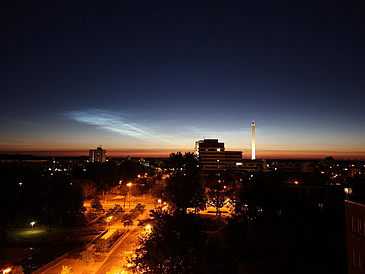In Bremen last Sunday, the early bird would have been able to witness a seldom occurrence in the dying night sky: Noctilucent clouds. This remarkable phenomenon was captured on camera by physicist Matthias Buschmann from the University of Bremen’s Institute of Environmental Physics.
As opposed to the tropospheric clouds we can see almost every day in Bremen, these ‘mesopheric’ clouds are at an extremely high altitude. Under normal circumstances, the clouds we observe are not higher than 13 km at the most.
Noctilucent cloud formations, on the other hand, can rise as high as 80 km into the sky. They are caused when water particles enter low-temperature zones in the upper atmosphere and suddenly freeze, forming tiny ice crystals.
The clouds are lit up by the sun. Although the sun itself is still below the observer’s horizon, the rays from the rising sun are already reaching into the mesophere.
One of the tasks carried out by a research group led by Prof. Justus Notholt is to measure the incidence of greenhouse gases in the atmosphere. This is done with the aid of a sun spectrometer housed in the large astronomical dome on top of the NW1 building (visit "Did you Know…). The measuring principle is based on the fact that in certain spectral ranges the greenhouse gases weaken solar radiation. It is then possible to calculate the concentration of greenhouse gases by measuring the extent of this weakening. Notholt’s research group carries out these measurements in cooperation with the Alfred Wegener Institute, which does the same in Arctic Spitzbergen, where between October and May there is no sun at all – only the dark polar night.
As part of his doctoral research, Matthias Buschmann is using the moon as a light source to measure the concentration of greenhouse gases during the long polar night in Spitzbergen. This new measuring technique still has to be tested for accuracy – and that is being done in Bremen. In the last few weeks the researcher has been taking measurements using the sun as the light source during the day, and the moon at night. It was in the course of this activity that he managed to capture this rare image of noctilucent clouds.

